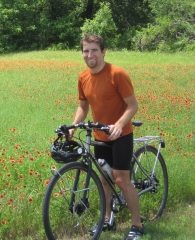Gearing Up
Now that I've nailed down a teaching position for this fall, it's time to go on an adventure! Since my school district requires me to take a course mid-June, then expects me back in early August for training, I only have a month and a half.
I have several items remaining on my bucket list: the Pacific Crest Trail, a bike tour of Australia, the Camino de Santiago, a bike tour in Europe, and some kind of still-undetermined adventure in Africa. I'm reaching the age at which I understand I'm not going to continuously get in better shape from here on out. As such, it's my idea that I should do the hardest ones first, and easier ones (like the Camino de Santiago) can wait until those are all I can do.
The Great Divide Mountain Bike Route is not a dedicated trail. Rather, it's simply a route put together to closely follow the Continental Divide, from Antelope Wells, NM (on the Mexican Border) to Banff, AB, a distance of ~4,400 km. As one might imagine, there are a lot of mountains. The vast majority of the route is on unpaved forest service roads, though there are some sections of singletrack trail, and also an occasional paved road, often when the route visits a town.

Since the route is mostly on gravel roads, rather than rugged trail, it's possible to do the entire thing on a rigid frame. Valeria wouldn't be such a bad bike for this route; in fact, I suspect the trail is no worse than the Dalton Highway in Alaska or the Carretera Austral in Chile. All the same, a mountain bike is recommended for the GDMBR, just as it was for the Dalton Highway and Carretera Austral, where I wished I had one.
Enter Jackie, a can-do workhorse. A few years ago, a co-worker at Google gave me a bunch of old mountain bike parts that came off his hybrid. None of them were the same, and he was replacing the entire drivetrain with matching parts. The thing is, these were good parts! I had an idea for a cool bike to make with them.
It took a while to get around to it, but I got a steel 29" mountain bike frame, some wheels that are equally applicable for mountain biking, touring, and commuting, and the rest was mostly pieced together from things I already had. Voila! A bike that's perfect for getting around town, can easily handle a dirt road or cut across the grass. Put a suspension fork on her and she's ready for any trail.
Jackie is named after a fictional character. High five if you can figure out who (her name's not Jackie).
There are a few things Jackie still needs before she's truly off-road tour-worthy:
- Suspension fork
- Mountain bike tires
- Mountain bike tubes
- Water bladder
- Trail maps
And a few things I could do the trail without, but could really use:
- Frame bag
- Suspension saddle
- Cycling rain jacket (I have a specific one in mind)
I seem to recall describing the Carretera Austral as "like having your shoulders violently shaken while receiving a swift kick in the pants, for hours at a time." A suspension fork will solve only one of those problems. A suspension saddle would solve the other.
A frame bag would be great because a mountain bike has limited options when it comes to carrying gear, and I won't be able to use a rack on the front this time around. So I need another way to carry my gear.
That said, I'm tempted to just use what I have. Touring can cost a lot of money if you buy everything that could come in handy.
Just like last time, I'm raising money for World Bicycle Relief, the coolest charity I know. And you can donate right here on my page! The bikes they provide to impoverished areas bring food to the hungry, medicine to the sick, jobs to the poor. The disease rate plummets, along with infant mortality, the local economy soars, and school attendance and grades skyrocket. All because they build and distribute cheap, durable bikes! Give 'em a hand, would ya?
Worth noting - the Tour Divide is a race on the Great Divide Route. Unlike most bike races, it's unsupported, and it's not staged at all. The clock runs continuously for weeks - if you want to stop to eat or sleep, others might overtake you. And there are no support vehicles, so the racers must carry their food, clothing, tent, spare parts, and everything else they need on their bike. They must set up their own tents, cook their own means, perform their own repairs, and take care of anything else that needs to be done to get them to the finish line. The Tour de France may be more competitive, but I'd wager the Tour Divide is harder.
A typical GDMBR tour takes 50 days. I'm trying to finish in 45 so I can get back to school.
The record is 19.



 June
June

